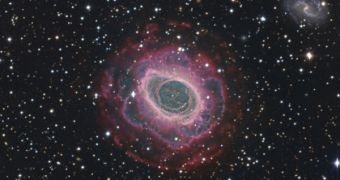The Ring Nebula is perhaps one of the most “popular” attractions in the sky, having been photographed on numerous occasions with virtually all telescopes capable of resolving it. By combining optical and near-infrared data of the formation, also known under the astronomical designation M57, experts at the Calar Alto Observatory (CAO), in Spain, managed to obtain a new view of it that presented the planetary nebula in a new light. According to AlphaGalileo, this is a unique photograph of the space structure.
The image captures not only the central zones of the nebula and its halo, but also a massive number of stars around it, and a huge number of background galaxies, each located at various distances from M57. Experts at the institution say that the photo is part of the Documentary Photo Gallery of Calar Alto Observatory, and that it is the first to be released after the recent image of the Owl Nebula. The two celestial structures are similar in many aspects, but most notably in that they are both members of the same class of nebulas.
A planetary nebula is formed by stars no larger than eight times the mass of our Sun. They are unable to explode as novas or supernovas, therefore, towards the end of their burning cycles, they emit a lot of their internal matter as stellar winds. After an additional few thousand years, they violently expel all the outer layers above their cores, which remain exposed as white dwarfs. The latter formations then begin to emit powerful ultraviolet radiation, which excites the atoms inside the surrounding layers, giving the newly formed structure, a nebula, its characteristic inner glow.
Numerous differences exist between the central zones of the nebula and its halo, the outer layer made of old matter, released as stellar winds. Chemical compositions vary with the distance each of the layers is located from the white dwarf, so radiation coming in from the core causes each of the layers to “shine” in different wavelengths. This is the main reason why the same formation looks entirely different when viewed in X-rays, UV, infrared, visible light, or microwaves.

 14 DAY TRIAL //
14 DAY TRIAL //